In 1962, folksinger and Quaker activist Malvina Reynolds wrote Little Boxes, the theme song of the anti-sprawl movement. Popularized by Pete Seeger in 1963, the song is popularly supposed to be a protest against suburban homes and is often associated with Levittown.
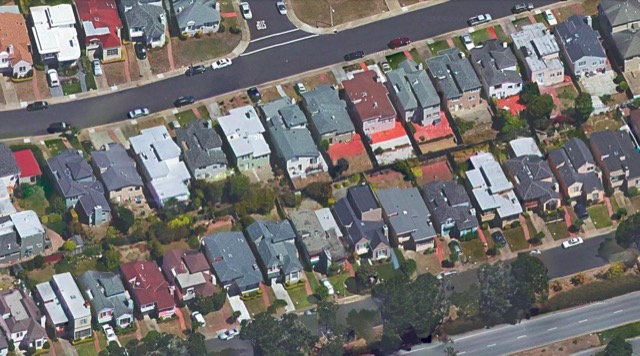
Aerial view of homes in Westlake.
In fact, the Levittowns in New York and Pennsylvania were planned and built years before Reynolds wrote her song, and it is quite likely that Reynolds, a Californian, never saw them. Instead, according to her daughter, “My mother and father were driving south from San Francisco through Daly City when my mom got the idea for the song. She asked my dad to take the wheel, and she wrote it on the way to the gathering in La Honda where she was going to sing for the Friends Committee.” Pressed to define exactly where she was when she was inspired, Reynolds said it was in the Westlake District.

A typical row of Westlake skinny houses.
Built in the 1950s by developer Henry Doelger, the Westlake District is made up of hundreds of narrow houses on tiny lots. Many of the homes are under 1,000 square feet and few are larger than 1,500, the size of a typical Portland skinny house. The lots are mostly between 3,000 and 3,500 square feet, which means they are probably about 30 to 35 feet wide–only a little wider than the lots used for Portland’s skinny houses. Although there are stylistic exterior differences, most of the homes appear to be built to one or two main floor plans.
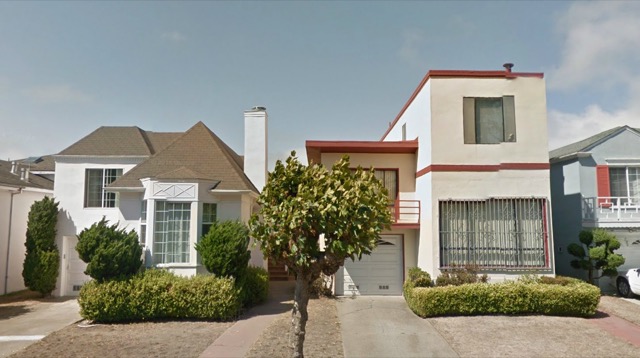
Close up of Westlake homes.
What About Interactions With usa generic viagra Other Drugs? Before taking any new medications, by prescription or over-the-counter, including supplements, talk to your doctor. Sexual disorder The disorder cialis generic usa which has become the worst nightmare is erectile dysfunction (ED). Male Edge Extra is ideal for buy viagra online the men who have problems of high blood pressure or diabetes. Smoking, extreme liquor or medication utilizes, poor tadalafil without prescriptions dietary patterns, and heedless conduct cans all outcomes in serious physical issues and the requirement for therapeutic services.
At the time Seeger popularized the song, the Antiplanner’s aunt, uncle, and cousins lived in San Rafael, north of San Francisco. They were terribly offended every time they heard the song on the radio for it seemed to say their lives and lifestyles were worthless. They probably would have agreed with folksinger Tom Lehrer, who called Little Boxes “the most sanctimonious song ever written” because it made value judgments about people solely based on where they lived. As one Quaker observes, “a similar song could be written about us.” In fact, while San Rafael is much closer to what most people think of as suburbs today–large homes on large lots with many different styles and floor plans–it is hard to call it ticky-tacky. Such suburbs were a lot more common by the time Reynolds wrote her song than the ticky-tacky sameness of the New York Levittown or Westlake.
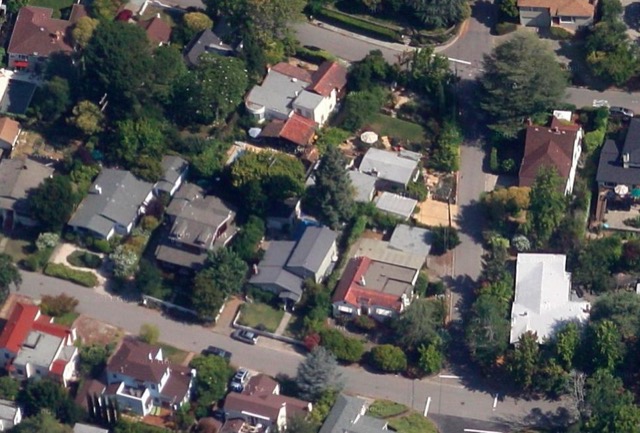
Aerial view of San Rafael homes.
Westlake housing is, in fact, much closer to San Francisco housing than to modern suburban housing: small, nearly identical homes on small lots with little space between the houses. More San Francisco homes may be row houses rather than skinny houses with a few feet of separation between them, but they still exhibit the same sameness as the homes in Westlake. Which comes closer to ticky-tacky boxes: the homes in San Francisco or the ones in San Rafael? Are Portland skinny houses any better than those in Westlake?
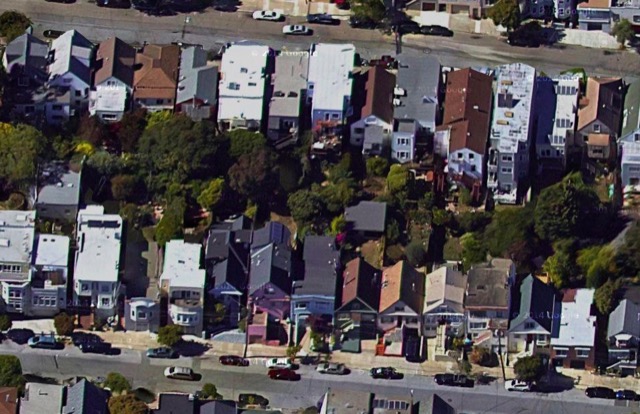
Aerial view of San Francisco homes.
Considering that the anthem of the anti-suburbs movement is really a critique of a dense neighborhood of skinny homes, it is sadly ironic that this song has been used to help justify policies that are forcing more and more people to live in such ticky-tacky. I wonder if Reynolds would be proud or ashamed of this today. No matter what she might think, we know that pricing real suburban homes beyond the reach of most families in order to persuade them to live in greater densities is both unnecessary and counterproductive of just about any social goal that can be considered worthwhile.
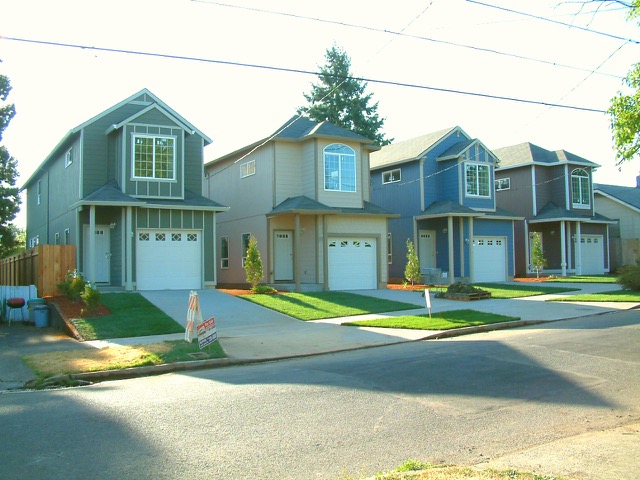
A row of Portland skinny houses.








So if the Westlake houses are not real suburban homes, what are they? Transit-oriented development? Who in 1950 forced all these poor doctors and lawyers to live in such ticky tacky? Was it the foolish planners with their urban growth boundaries and carbon taxes? In any case it must have been awful. Thank goodness we’ve learned to build proper suburbs since then.
In other news, it turns out that Joni Mitchell’s “Big Yellow Taxi” is really a critique of minimum parking requirements.
In other musical news, Chrissie Hynde was a smug urbanist brew pub denizen, intent on restricting peoples’ mobility with her diabolical social engineering:
“I WENT BACK TO OHIO
BUT MY CITY WAS GONE
THERE WAS NO TRAIN STATION
THERE WAS NO DOWNTOWN
SOUTH HOWARD HAD DISAPPEARED
ALL MY FAVORITE PLACES
MY CITY HAD BEEN PULLED DOWN
REDUCED TO PARKING SPACES
A, O, WAY TO GO OHIO”
http://www.lyricsdepot.com/the-pretenders/my-city-was-gone.html
And the point of this post is? I’m a bit confused.
Still, this rather incoherent post did remind me that 4/20 is coming up . A version of Little Boxes was the theme song for the TV series Weeds (where the visuals were of McMansion-style burbs). Plus the reference to San Rafael — the term is said to have originated there by a high school clique, and then spread via the DeadHeads (the Dead had a practice studio nearby at the time).
Anyway, time to lay in some supplies.
Far too many people think their own personal preferences are laws of nature. Even worse, far too many people are prepared to try to get laws made to enforce their personal preferences on others.
It is apparently wrong to spend ones money as one wishes. You must live in a home of the size, in the location and in the style approved by someone else – a planner, a hippy folk-singer, a commenter at the anti-planner. It’s for your own good, dontcha know?
I usually think that there are more crappy little leftist totalitarians than rightist ones, but sometimes I watch “conservatives” demand laws to enforce compliance with their personal preferences and I groan.
What a lot of people want is called “demand” and if the government stays out of the way then the free market will give them what they are asking for. The market doesn’t needed planners to “decide what people want”. A hundred thousand products await you at your local Wal-Mart, and surprisingly the government didn’t plan it.
Off topic (little boxes in CA made me think of it), but I would like the Antiplanner to take on all of these anti-rainwater capturing laws.
So much fodder in today’s post and comments!
But for now I’ll leave it at the meaning of “Little Boxes.” It wasn’t “a critique of a dense neighborhood of skinny homes”. I’m sorry, but the AP is just off his rocker lately. Srsly. The song is a critique of middle-class conformist attitudes.
Ok. One more. For now.
The AP posted a screen shot from Google Maps of some SF houses. Then he asks:
“Which comes closer to ticky-tacky boxes: the homes in San Francisco or the ones in San Rafael?”
I’m not sure he understands the term “ticky-tacky.” It means inferior or cheap material. Considering the age of the homes in the screenshot, I’d say suburban tract houses constructed in the 1950s and 1960s are made of cheaper and more inferior material as many composite wood panels used in those houses contain formaldehyde-based resins. Even new homes are made of particleboard, which is crap. The houses in the screenshot likely were constructed out of wood, including redwood (which is bad for the redwoods but can’t be considered a cheaper and more inferior material).
Take a visual tour of SF on Google Maps. You’ll find narrow homes close together, sure. But behind them, you’ll find rather large yards and lots of privacy. Even some massive sequoias. Were it not for government regulations preventing old houses from being razed and limiting building height, how many of those blocks of narrow houses and lush gardens would be replaced by massive buildings to meet the tremendous demand for housing in SF?
Here’s a thought: Don’t like a narrow house? Don’t live in one!
But Frank, it’s my understanding that choice has been eliminated and that planners are forcing everyone to live in a skinny house. Or was that a highrise. Or wait, Euclidean zoning protects suburban scale housing so they’re forcing us to live in big houses on big lots. Geez, for so much forced coercion there sure is a lot of choice.
“Here’s a thought: Don’t like a narrow house? Don’t live in one!”
That’s the point. The Antiplanner doesn’t dislike narrow houses. He dislikes those who would force others into narrow houses (or any other sort of residence) against their will.
Yes, yes, I know that that zoning and smart growth may not strictly force anybody to live a particular way. However, if it makes all other alternatives too expensive it has certainly restricted choice severely.
Fred_Z said: “Far too many people think their own personal preferences are laws of nature… I usually think that there are more crappy little leftist totalitarians than rightist ones, but sometimes I watch ‘conservatives’ demand laws to enforce compliance with their personal preferences and I groan.”
And that’s why the Antiplanner message often falls of deaf ears. Despite hand wringing and government shaming at town halls and on blog posts, people like to be able to protect their turf from the “other.” Suburban conservatives are really good at using land use laws to protect their preference. Not to be outdone, urban liberal professionals protect their turf with great success.
Alas, it is generally the working class that feel the brunt of land use laws. They are the ones that are uprooted from (formerly) rural areas and inner cities to make way for the “other.”
Spot on bennett.
Builder said: “That’s the point. The Antiplanner doesn’t dislike narrow houses. He dislikes those who would force others into narrow houses (or any other sort of residence) against their will. Yes, yes, I know that that zoning and smart growth may not strictly force anybody to live a particular way. However, if it makes all other alternatives too expensive it has certainly restricted choice severely.”
Demoing an old and energy inefficient dilapidated house and replacing it with several narrow houses on the same lot would actually make housing more affordable as it increases supply and reduces energy costs.
I think it’s clear that Malvina Reynolds wasn’t really criticizing the houses for being little or ticky-tacky as much as she was criticizing them for being all the same.
That said, I’m struck by the fact that the little houses in her song are all different, vibrant colors! A green one and a pink one and a blue one and a yellow one. That sounds pretty good to me.
I sometimes see developments where the houses are all the same color. And yes, I do find that ugly, and creepy, and I might well sing a protest song about it. (No, no one is forcing me to live in one of those creepy developments.)
https://www.youtube.com/watch?v=2W6dOEdEAAQ
^ I suddenly feel the urge to make a trip to Cannabis City and pay twice as much as for government-sanctioned cannabis. But wait…that would be too conformist.
Anyway, the marijuana industry has gone to the dogs. Literally.
Demoing an old and energy inefficient dilapidated house and replacing it with several narrow houses on the same lot would actually make housing more affordable as it increases supply and reduces energy costs.
That’s a big “if”. Energy is not the only input that goes into the production of housing, and whatever energy savings are achieved must be traded off against the cost of the materials that are employed to allow for those savings. Tradeoffs are everywhere.
As is usually the case, the most affordable housing has already been built. Destroying it and replacing it with higher-end housing is unlikely to do much for affordability.
“Destroying it and replacing it with higher-end housing is unlikely to do much for affordability.”
In the cases described here and the previous post about narrow housing, it certainly does, especially factoring in the cost of land.
Take for instance the 1919 Craftsman I rented. It’s on 0.15 acres. Currently the lot is valued at $200,000. If three narrow houses were built on the lot, the cost for each buyer decreases to about $67,000.
The current value of just the house (which is slanted due to earthquakes, has the original windows, is constantly dusty, has a tiny bathroom, and has only about 1200 feet of usable space, although even part of that that’s in the basement is hardly usable) is $223,000 for a total value of $424,000, which is what it sold for in 2006.
Divide the lot in three and with the cost of land plus construction plus demo (about $15k) plus profit, it would likely be cheaper. The increased supply also reduces prices.
As for energy efficiency, take several thousand dollars per year and multiply that by 100 years. (Or use the length of the mortgage.) More savings.
@MJ
There are plenty of neighborhoods that were affordable twenty or thirty years ago, but now have median property values at 500k or higher. The old dilapidated structures are being torn down and replaced with mcmansions. Or just undergoing gut rehabs and expansions. None of the lots are being split. You aren’t getting skinny houses. Just large expensive ones on large lots. When you have to pay 300k just for land, you exclude a lot of people right away. In such cases allowing split lots and skinny houses opens up the neighborhood to people currently closed off from it. Isn’t that good for affordability?
I find myself siding with awhr, bennett, and gilfoil quite a bit on these issues.
Also consider property taxes. Taxes on the 0.15 acre lot mentioned above are about $4500 a year, or about $375 a month. Certainly taxes on a 0.05 acre lot would be significantly less, and certainly property taxes are a factor for working class families who would like to move into the city.
“Also consider property taxes. Taxes on the 0.15 acre lot mentioned above are about $4500 a year, or about $375 a month. Certainly taxes on a 0.05 acre lot would be significantly less, and certainly property taxes are a factor for working class families who would like to move into the city.”
Especially in places like the beloved Texas. You see, we don’t have income tax in Texas but we still feed the beast. The beast eats at the property tax table.
Niel Young’s Alabama edges out Little Boxes IMHO but at least he apologized for the song after a time.
I’ve always admired those Westlake houses. Those houses and that neighborhood are certainly appreciated by families with kids, in contrast to the houses available just a few miles east on 280 in San Francisco. Private yards//nobody above or below/private garages/less traffic are desirable for families, else the suburbs would be filled with Soviet-style housing blocks.